In this Article:
Try Kanbanchi now
Start your free trial

The right project management tools can reduce manual work, improve team collaboration, and drive project success for teams in almost any business or project-oriented environment.
Finding the right tool, however, can be challenging, with hundreds of solutions out there. Businesses sometimes invest in tools before truly figuring out what they need, leading to poor adoption rates, wasted budgets, and continued inefficiency.
For businesses embedded in the Zoho ecosystem of apps, Zoho Projects may seem like the answer for project management. However, many quickly seek a Zoho Projects alternative when they discover that the tool doesn’t quite do what they expected.
In this article, we examine the best eight Zoho Projects alternatives in 2025, so that you can decide which is right for your business without having to try them all.
Organizations that have adopted Zoho Projects are often deeply embedded in the Zoho ecosystem of business software. The Zoho One suite includes modules like CRM, WorkDrive, Desk, Analytics, etc., and the typical Zoho One customer uses 16 Zoho apps. More than 45 apps make up the entire ecosystem.
Because project management is a key function for many organizations, they need high-performing software for seamless collaboration and efficiency. While Zoho Projects does a decent job on many levels, it doesn’t offer many of the features and benefits offered by Zoho competitors.
Zoho Projects receives a 4.3 rating on G2, which isn’t bad, but can certainly be improved upon, as we will see.
Teams are looking for Zoho Projects alternatives in 2025 mainly because of:
Choosing the right Zoho Projects alternative depends on your current work environment. For instance, those deeply embedded in Google Workspace environments will want a tool that integrates natively with Google Drive, Gmail, Calendar, etc. Those who mainly work with Microsoft Teams will have different integration requirements.
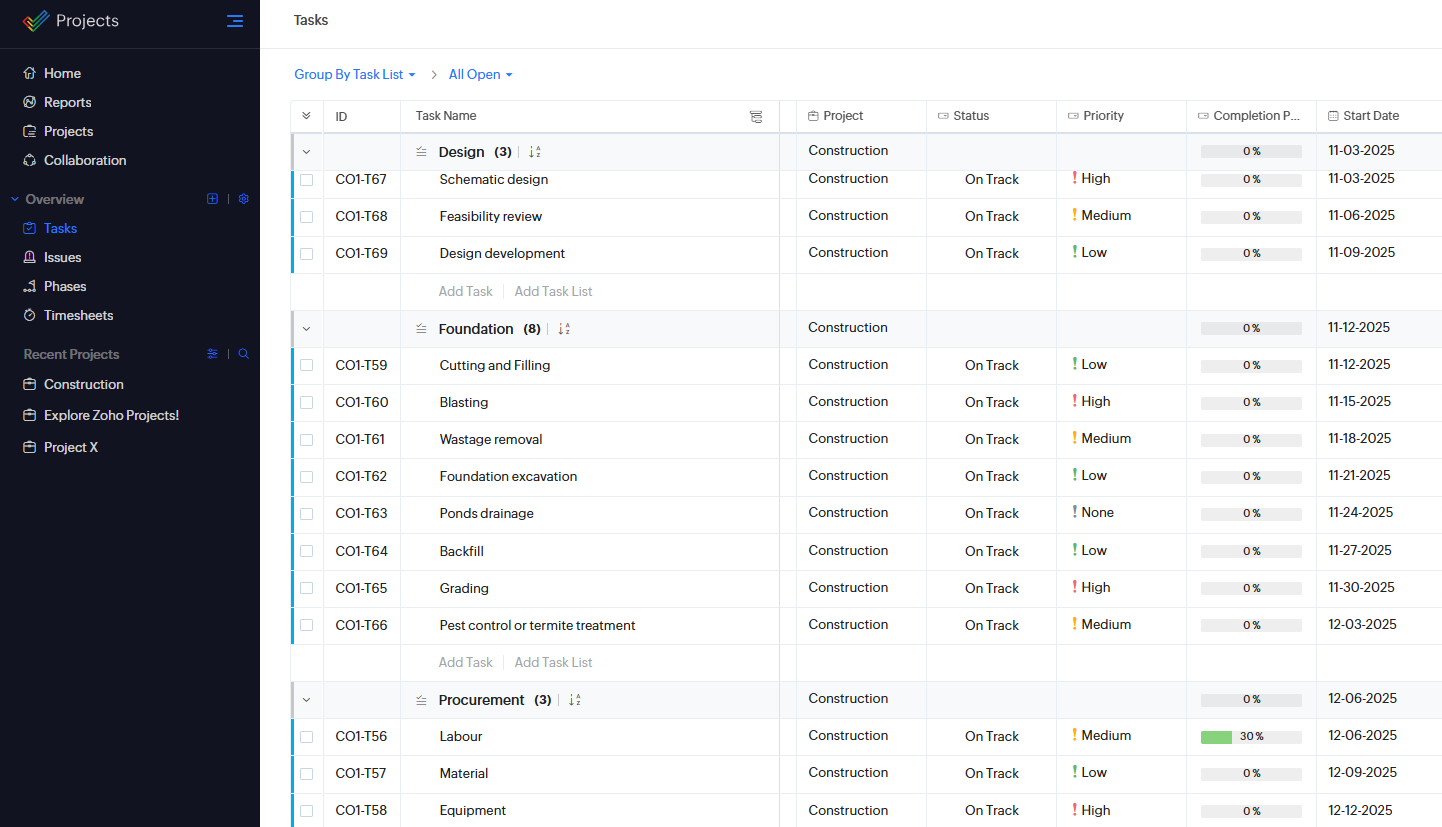
Factors to consider when selecting the best Zoho Projects alternative, including integration, usability, features, and scalability.
Beyond the integration needs of the organization, a comprehensive assessment of the best Zoho Projects alternatives requires an in-depth analysis of the following:
Here’s a rundown of the top eight alternatives to Zoho Projects, with a quick analysis of the main criteria above.
The target users of Kanbanchi are teams of almost any size operating in Google Workspace environments and needing a project management and collaboration tool that does a little more than most.
That’s because Kanbanchi was built from the ground up in 2014 for Google Workspace-based teams.
In its simplest form, Kanbanchi provides an at-a-glance work view in the classic Kanban board style, ideal for simple task collaboration and project management. It offers seamless integration with Drive, Calendar, Gmail, and Sheets. Native integrations mean that work can be managed without the need to switch between multiple Google apps.
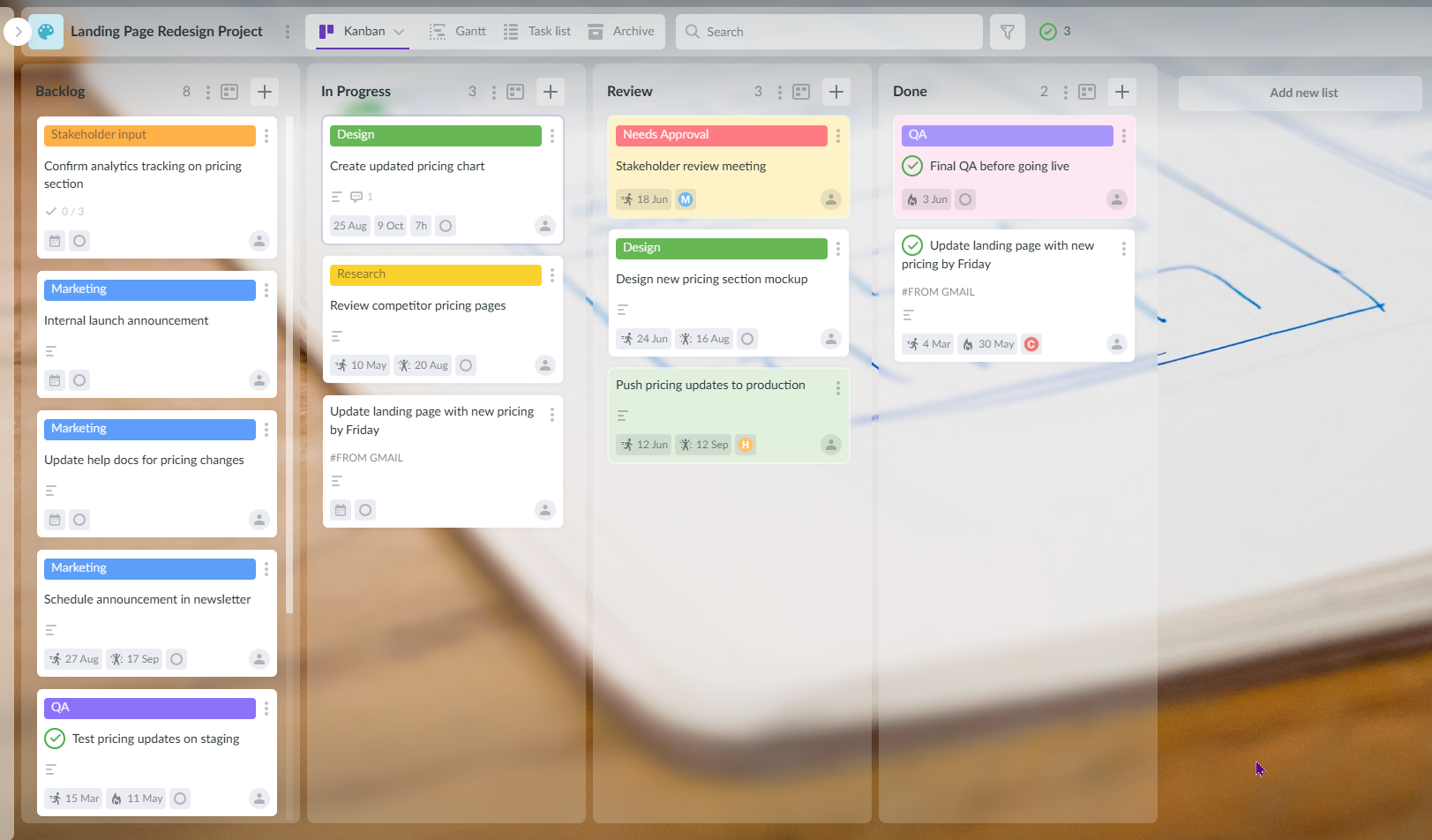
Kanbanchi offers seamless Google Workspace integration and a familiar Kanban interface for enhanced productivity
Individual professionals, freelancers, small and medium-sized teams in larger organizations, and enterprises can use Kanbanchi as a centralized project management hub for better control over project processes and enhanced efficiency.
The visual workspaces help project managers create, assign, schedule, and track multiple tasks centrally, while coordinating remote work and managing agile projects.
Security and data integrity are assured because Kanbanchi requires no new login credentials, using Google’s existing infrastructure. Board files are stored on Google Drive and SSO options are supported through Google Workspace. Admins can deploy it across the organization via the Admin Console with one click.
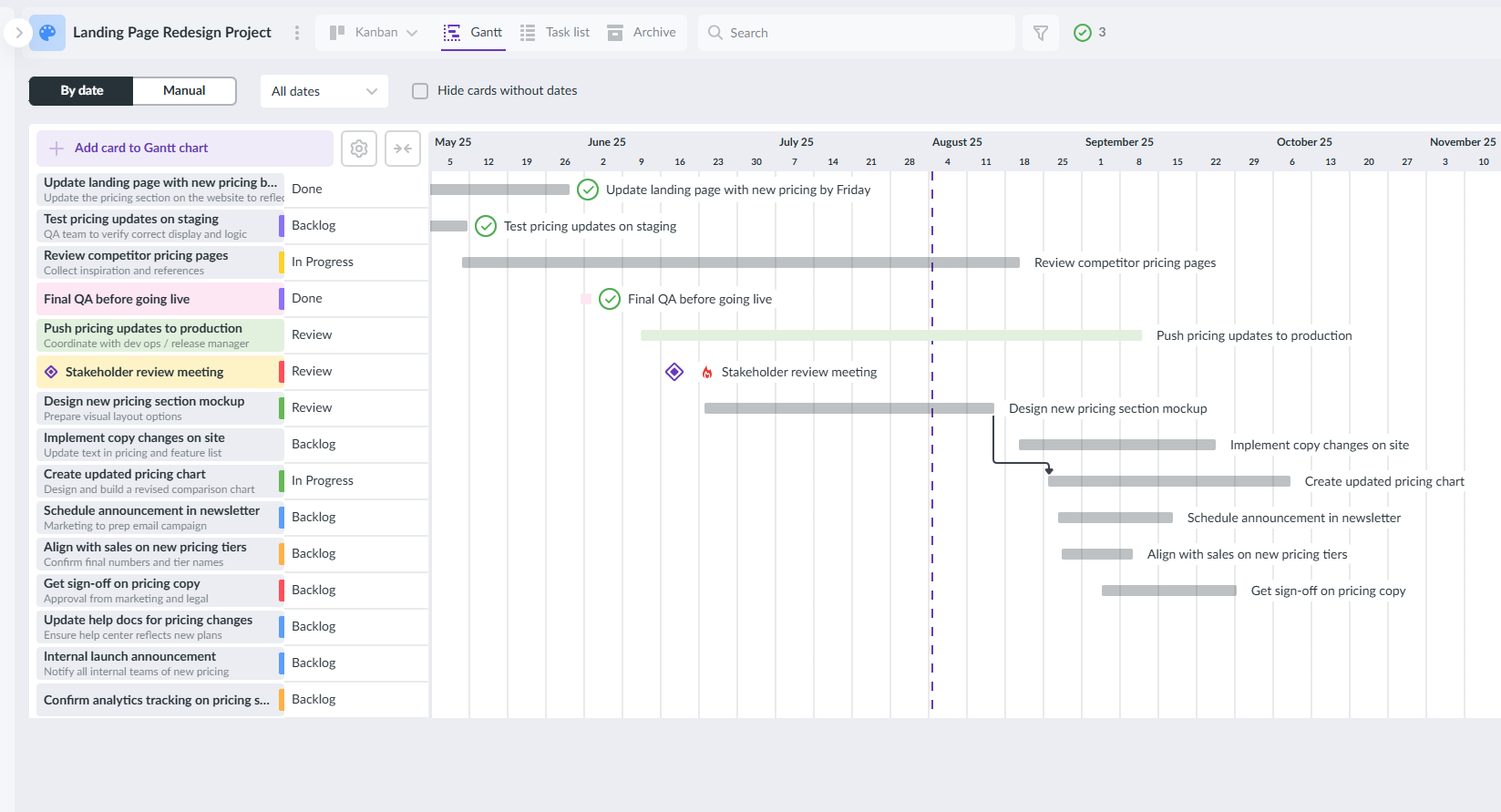
Kanbanchi supports visual workspaces, Gantt charts, and centralized task tracking for teams of any size
Select Kanbanchi as your Zoho Projects alternative if you want small to medium-sized teams to work seamlessly with advanced project management tools in a Google Workspace environment.
Kanbanchi is easy to set up and use and should be readily adopted by teams with even a little project management experience. Complete beginners will also pick it up quickly.
Teams in education, corporate environments, and nonprofits consistently choose Kanbanchi and rate it highly, not least because of its excellent support.
Kanbanchi for Google Workspace’s 4.7 rating on G2 and a similar rating on the Google Workspace Marketplace make it one of the best-rated project management tools and a naturally strong Zoho Projects competitor.
Asana is a versatile and popular project management platform that is used widely across large enterprises and midsize businesses as an alternative to Zoho Projects.
Asana offers flexibility for managing tasks, projects, and workflows, with a relatively simple user interface and a manageable learning curve for new users. It provides a robust feature set that allows the tools to scale with growing teams.
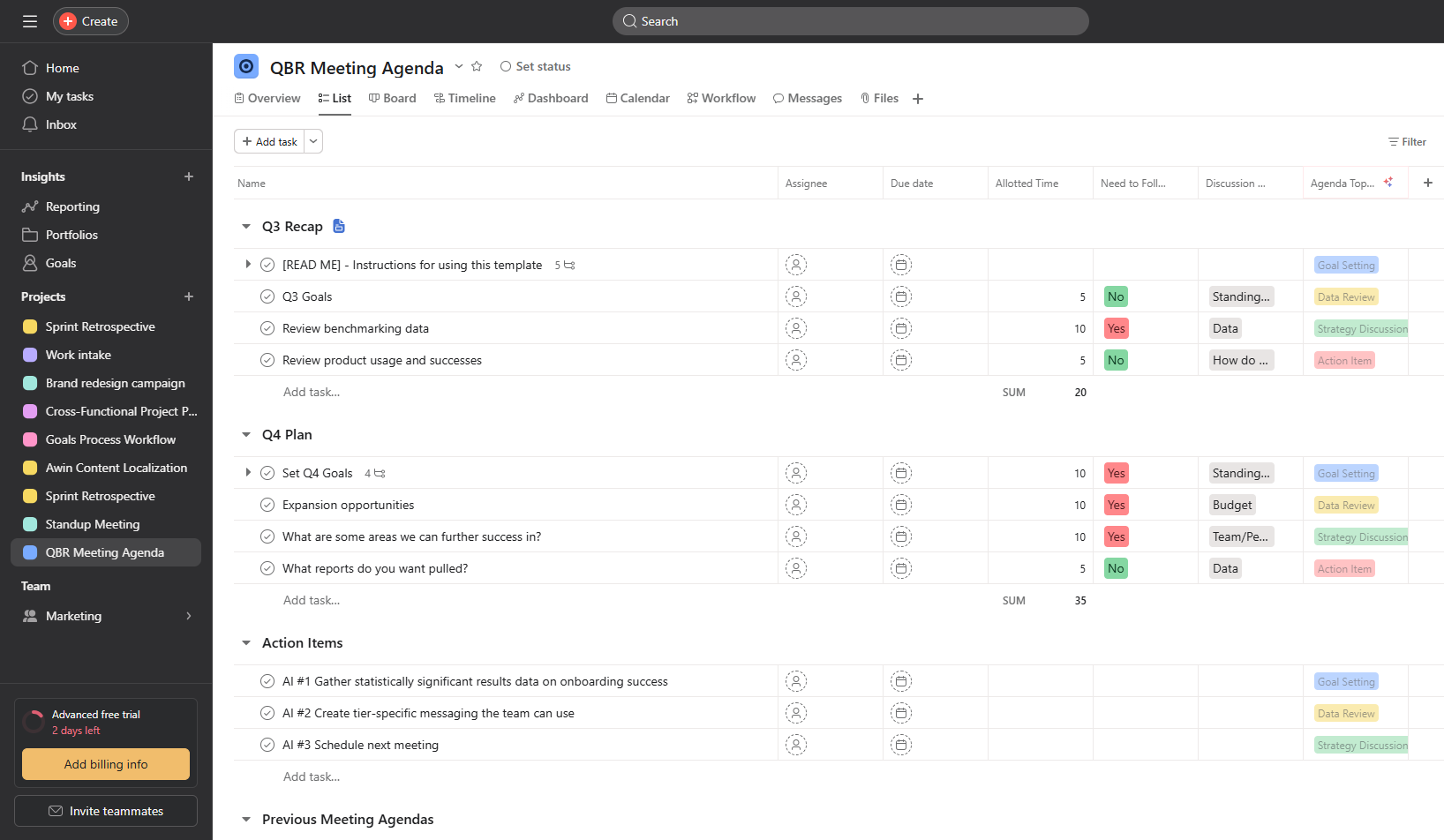
Asana enables structured task management with multiple work views and powerful automation features
Classic project management tools like task dependencies, Calendar views, and Gantt charts are supported by Asana, as well as the more typical list view and Kanban boards for planning, managing, and collaborating on projects.
Asana is an enterprise-ready task management tool, allowing detailed task creation with subtasks, assignees, due dates, and priorities. Tasks can be linked across multiple projects, reducing duplication, and work involved in repetitive tasks can be reduced by built-in rules and custom automation.
Asana offers many integrations and a well-developed mobile app to help teams collaborate from anywhere in real time.
Asana is a flexible Zoho Projects alternative for teams that need to manage complex workflows and tasks. While it can scale effectively to enterprise level, it may be overkill for smaller teams or more basic requirements.
Asana earns a 4.4 rating on G2 but a lower rating from Google Workspace users (4.0), suggesting that such users might be better off choosing Kanbanchi as a Zoho Projects alternative.
Trello is another of the most popular alternatives to Zoho Projects, using a simple task management system based on the Kanban method.
Part of the Atlassian suite of software solutions, Trello is collaboration-friendly and offers many integrations based on third-party apps (power-ups) that extend its native functionality.
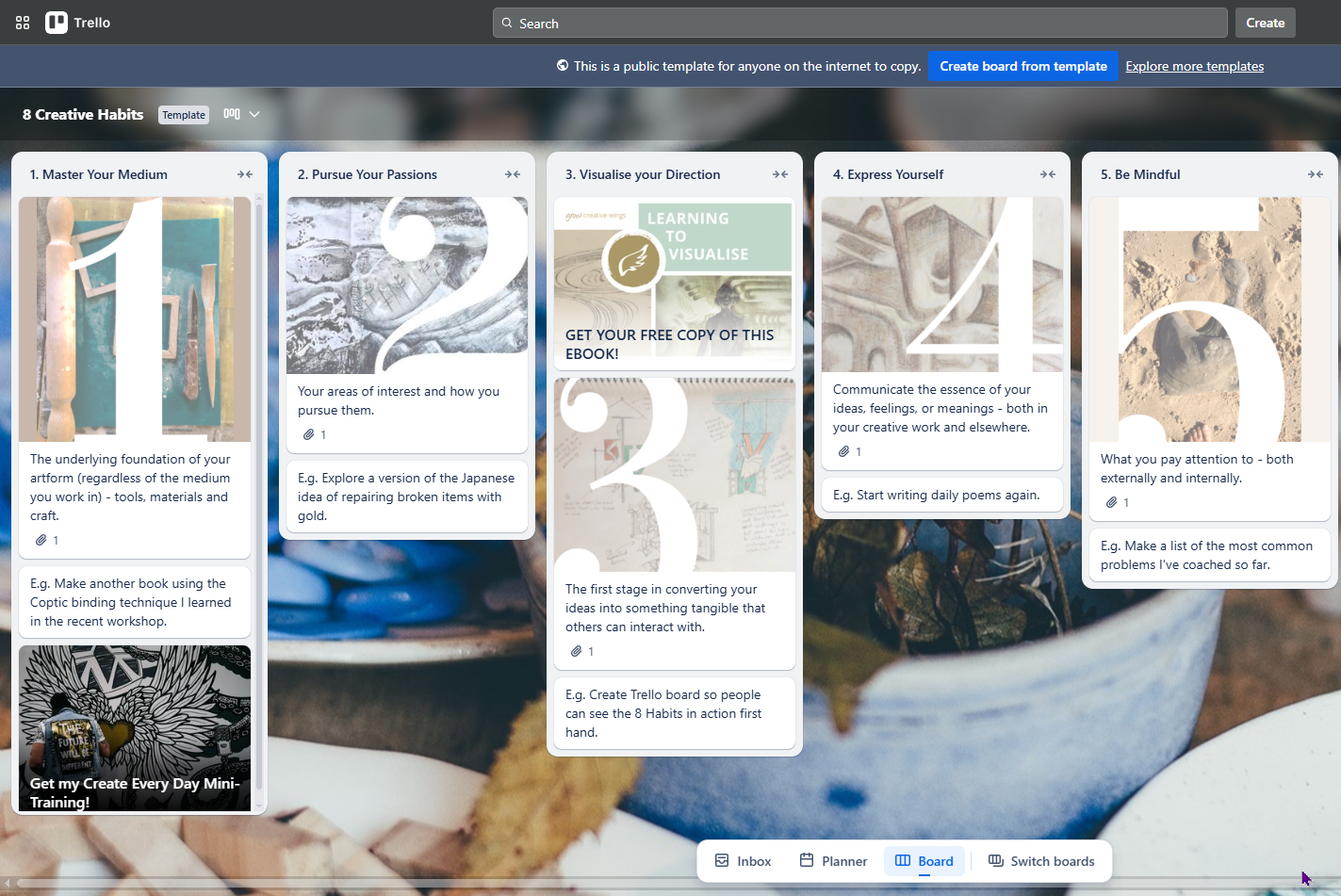
Trello uses a drag-and-drop Kanban interface for straightforward project planning and collaboration
Geared mainly towards individuals, freelancers, and small teams with relatively simple project management requirements, Trello’s ease of use and small learning curve make it attractive for non-technical users. However, some users may require assistance with the third-party integrations.
The free plan offered by Trello attracts many users and offers most of the features that individuals or small teams look for in task management. However, more complex project management requirements are better supported by other Zoho Projects alternatives outlined in this article.
Trello could be an effective Zoho Projects alternative for teams that prefer simplicity and ease of use over complex project management features—and don’t mind working with third-party integrations to extend its functionality.
With Trello earning a 4.4 rating on G2, it is a well-respected task management tool, especially amongst freelancers and small/midsized teams.
Wrike is an enterprise-ready project management tool used by many larger teams and organizations with advanced requirements.
A high-level and scalable alternative to Zoho Projects, Wrike offers advanced task management features for complex project planning and execution, with task dependencies, milestones, and critical path analysis. It also provides excellent options for integration and enterprise-grade security and compliance features, with data encryption, customizable user permissions, and GDPR compliance.

Wrike offers customizable dashboards, real-time editing, and advanced reporting for complex projects
Customizable features add to the rich offering, with customizable dashboards and performance reports on offer.
As a centralized project management hub, Wrike is a worthy Zoho Projects alternative for many larger organizations but overkill for those with simpler requirements.
Wrike is one of the strongest Zoho Projects competitors for organizations requiring comprehensive and customizable project management tools or who expect to scale during a period of growth.
The feature set may be overly advanced and the costs may be too high for smaller teams with simpler project management requirements, who may want to consider more user-friendly and cost-effective options.
Wrike scores 4.2 on the G2 review platform, suggesting a good but not unbeatable performance from its thousands of users.
Monday is a strong option to replace Zoho Projects if you’re seeking a highly visual, flexible, and user-friendly tool with good team collaboration features.
An intuitive design is accompanied by some advanced features, such as customizable dashboards and workflow automation. Integrations with many other apps via third parties extend the project management functionality of Monday beyond its native integrations.

Monday combines visual work views and automation features for scalable team collaboration.
Kanban boards and Gantt charts offer classic project management work views, while repetitive tasks can be automated. A library of customizable templates provides done-for-you ways to start projects without much team effort required.
Collaboration tools include comments, real-time editing, and file sharing, helping teams to work productively on projects together.
Every type of organization, from small and medium businesses up to enterprises, can use Monday.
Monday was traditionally used more as task management software by smaller teams to set deadlines, assign tasks, and track tasks. Extra integrations and customization with the paid plans can turn Monday into a more advanced project management solution to handle more complex situations.
Monday’s flexibility makes it a good choice both for small teams that want an easy-to-use, visual, and collaborative tool and larger teams that demand scalability up to enterprise level, with multiple projects managed simultaneously.
Monday scores 4.7 on G2, putting it equal with Kanbanchi. Both have native Google Workspace integrations but Kanbanchi’s integration is far deeper—and that may be the clincher for Google-based work environments.
Smartsheet is another of the leading Zoho Projects alternatives that might be favored by organizations that are used to working in spreadsheet-oriented environments.
Detailed project plans, budget tracking, and resource management options give Smartsheet robust project management and collaboration features within the familiarity of its spreadsheet grid-based interface.
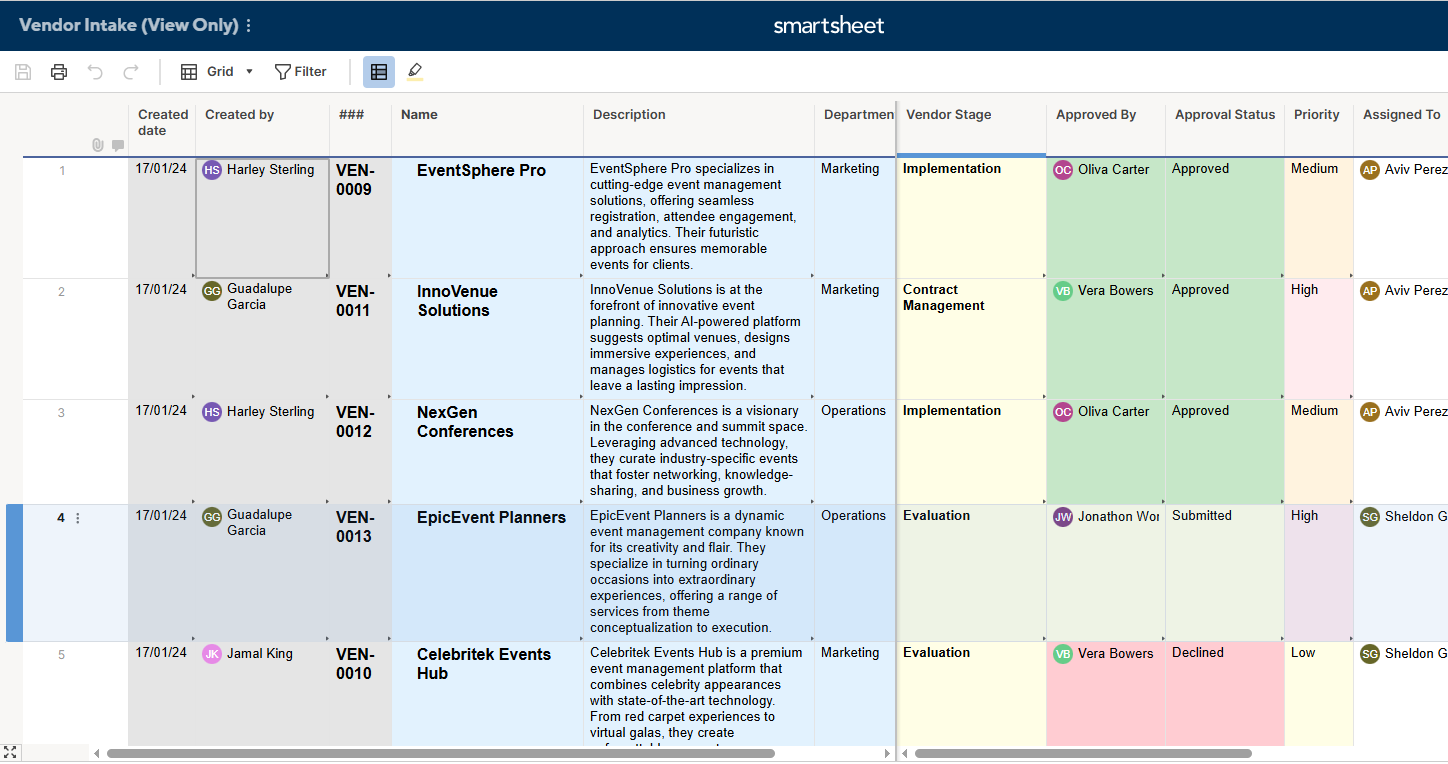
Smartsheet is ideal for spreadsheet-oriented teams needing robust project tracking and automation.
Powerful automation features that can trigger actions like reminders, approvals, and task assignments. These combine with multiple work views (including Gantt Charts and Kanban boards) to provide an efficient and versatile tool.
Smartsheet is probably most productive and cost-effective for midsize and larger organizations that need to manage, automate, and report on tasks within work projects, rather than smaller organizations, for whom the starting price might be a little off-putting.
Smartsheet might be a viable alternative to Zoho Projects for teams in large businesses and enterprises that are spreadsheet-based and require advanced project planning and resource management tools—or organizations transitioning from traditional spreadsheets to a more structured project management environment.
Smartsheet offers powerful automation and collaboration features that are well-received by users, earning a decent 4.4 rating on G2.
ClickUp is another serious alternative Zoho Projects, offering a comprehensive, feature-rich, all-in-one centralized platform from which to manage projects.
With many automation, integration, and customization options, ClickUp is scalable up to enterprise level and well-suited to organizations with moderate or advanced project management requirements (midsize to larger businesses and enterprises rather than solo professionals or small teams).
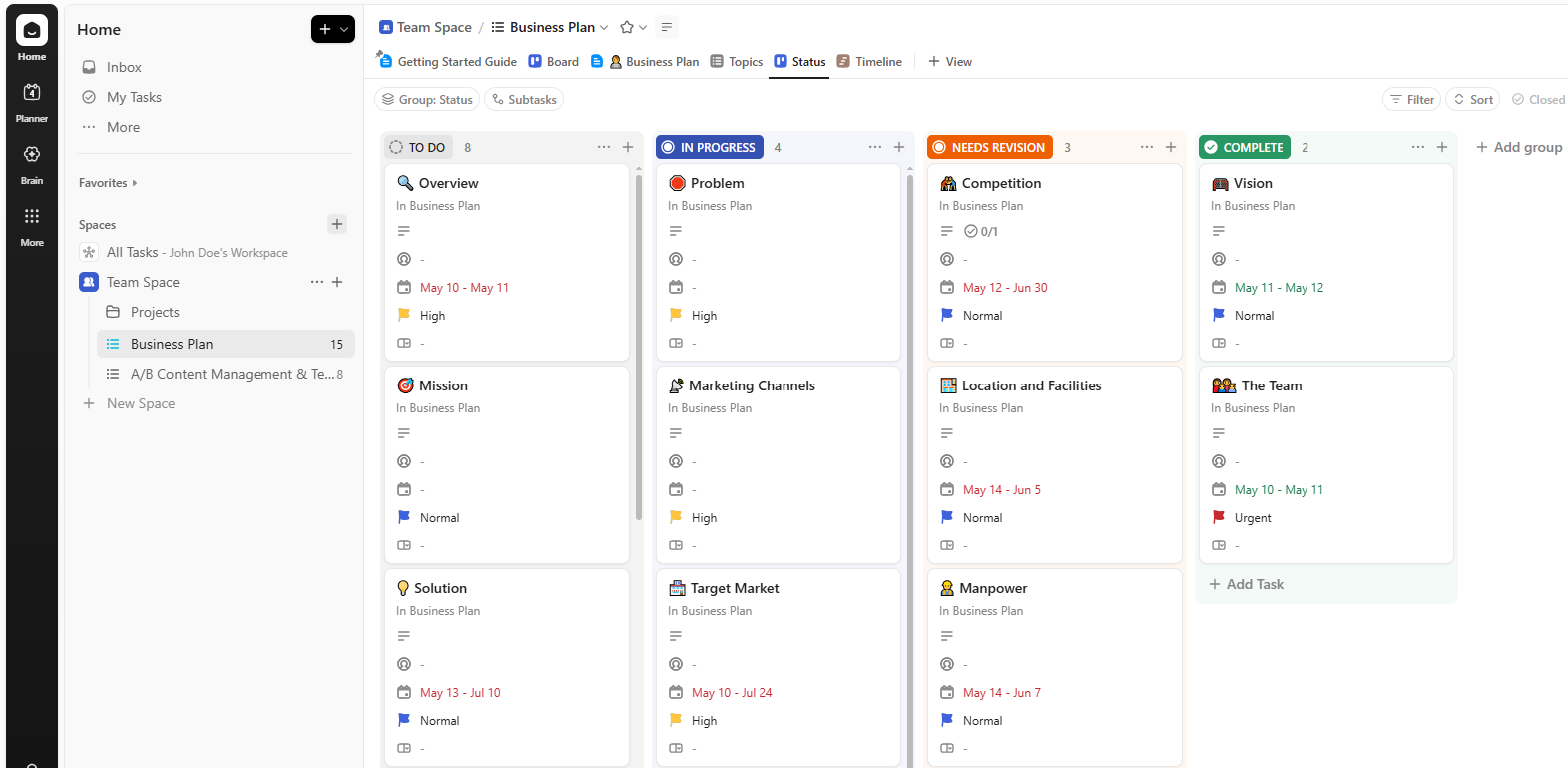
ClickUp offers a comprehensive and customizable solution for teams needing centralized project control.
Multiple work view options are available, while customizable workspaces, built-in docs, whiteboards, and time tracking provide advanced options.
For mobile users, the iOS, Android, and Windows apps are reasonably well-reviewed and allow project collaboration from almost any device.
ClickUp is a viable Zoho Projects alternative for teams looking to manage projects centrally from one platform with well-developed project management tools that keep project documents, goals, time tracking, and team communication in a single interface.
Flexible and customizable, the paid plans with the more advanced features may be unnecessary for smaller teams with simpler requirements.
With a 4.7 rating on G2, ClickUp is right for a lot of organizations—but is it right for yours?
Teamwork is designed for agencies, service providers, and organizations that manage client projects, collaborating closely and requiring powerful, enterprise-level tools to communicate and get work done.
Teamwork’s features include client portals, time tracking, and invoicing capabilities that extend beyond the functionality of Zoho Projects, helping organizations manage clients and finances as well as projects.
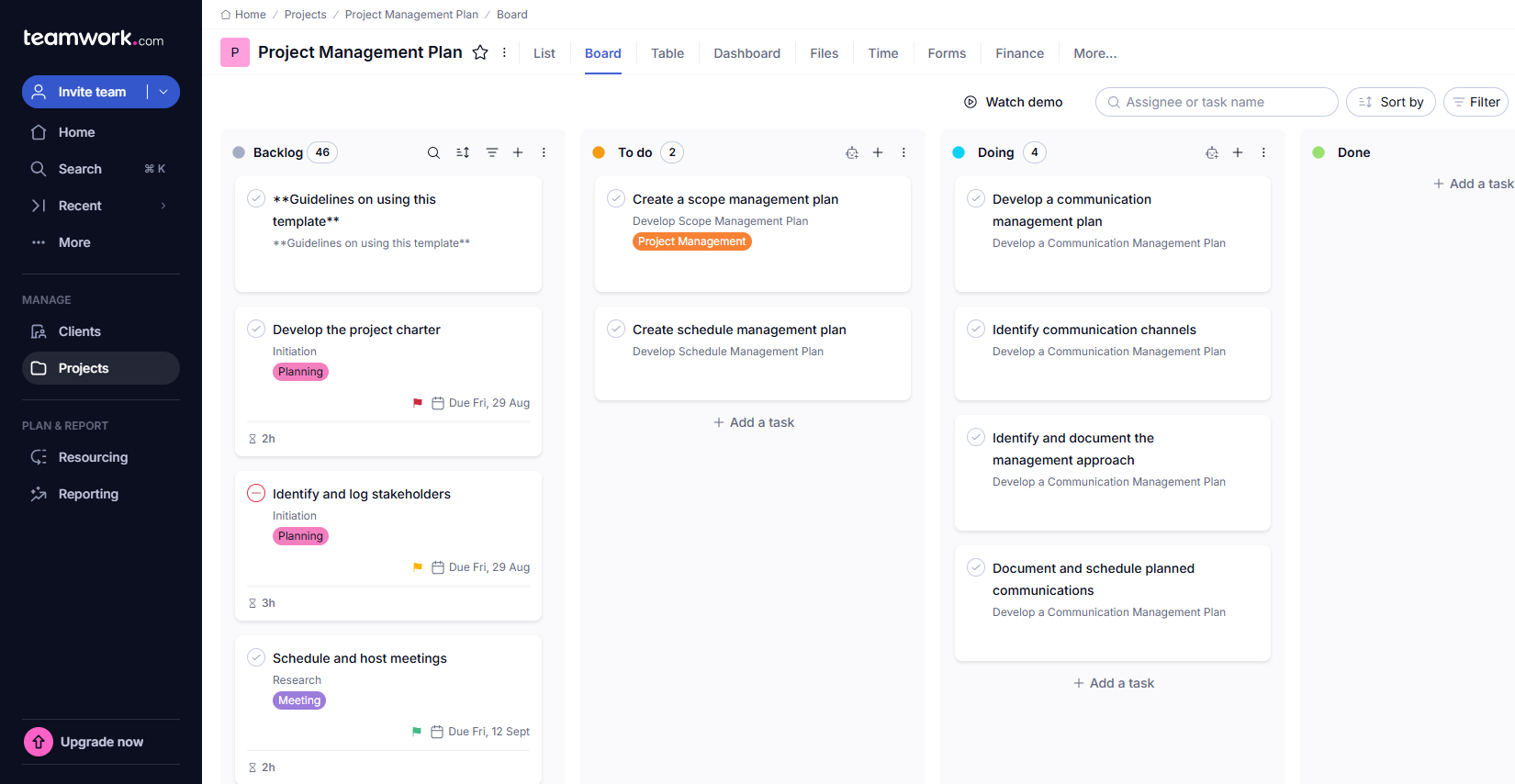
Teamwork is a powerful Zoho Projects alternative for agencies managing client work and invoices
These features will be overkill for many organizations with simpler needs and tighter budget constraints or with tools already in place already for invoicing clients, etc.
Teamwork’s permissions are highly customizable and secure but access issues or confusion can result unless these are carefully managed.
You might choose Teamwork as a Zoho projects alternative if you work closely with clients, managing projects for them and needing to track time and invoice them all from one platform.
Teamwork performs this task very well for service providers and agencies, for whom the extra functionality will justify paying a little extra per month.
Teamwork earns a 4.4 rating on G2, making it a strong performer but trailing tools like Kanbanchi.
Here’s an at-a-glance view of the main Zoho Projects competitors assessed above, including an overview of pricing:
| Tool | Best for… | Pros | Cons | Pricing* |
|---|---|---|---|---|
| Kanbanchi | Enterprises
Midsize team Small teams Solo professionals Freelancers Education Not for profit |
Customizable workflows.
Native Google Workspace integration. Multiple work views, including Gantt Charts. Excellent support. Excellent reviews. Highly secure with SSO. Scalable up to enterprise. |
Limited mobile app.
Limited free plan. |
Starts at $5.99 for a single user/month.
Premium, Professional, and Enterprise plans from $9.49, depending on the number of seats. |
| Asana | Enterprise & large organizations
Midsize businesses Not for Profit |
Advanced task management tools.
Good automation options. Extensive integrations. AI tools. |
Potential overkill and confusing for teams with basic requirements.
No native time-tracking. Can become expensive for larger teams. Detailed reporting only in higher paid plans. |
Starts at $13.49/user/month.
Advanced and Enterprise plans from $24.99/user/month. |
| Trello | Individuals
Freelancers Small businesses Midsize businesses |
Simple drag-and-drop interface.
Many power-ups for integrations. Customizable boards. Generous free version. |
Few native integrations (no Google Workspace).
Some learning curve with power-ups. Potential security/privacy issues with free version. |
Starts at $6/user/month.
Premium and Enterprise plans from $12.50/user/month. |
| Wrike | Enterprise
Midsize businesses Large businesses |
Centralized & advanced PM hub.
Enterprise-grade security & permissions. Advanced reporting options. Extensive integrations. |
Overwhelming for non-tech users.
Paid plans start at a higher monthly rate than many other tools. Cluttered, unintuitive interface for some users. Limited offline access. |
Starts at $10/user/month.
Business, Enterprise, and Pinnacle plans start at $25/user/month. |
| Monday | Small & mid-sized businesses
Large businesses & enterprises |
Multiple work views.
Rich library of in-built templates. Customizable dashboards & reporting. Workflow automation & time-tracking. Many third-party integrations. |
Learning curve for configuration and scaling.
Overwhelming for non-tech teams. Entry pricing is high. No native chat or messaging. Support can be below par. |
Starts at $12/user/month.
Standard and Pro plans starting at $14/user/month. |
| Smartsheet | Midsize & large organizations familiar with Excel/Sheets-based work environments | Familiar grid/spreadsheet-based interface.
Automated workflows. Large template library and extensive integrations. Secure, scalable, and customizable for enterprises. Resource management features. |
Higher starting rates than other tools.
No free version. Too spreadsheet-heavy for creative or agile teams. No offline access to edit sheets. |
Starts at $12/user/month.
Business, Enterprise, and Advanced Work Management plans start at $24/user/month. |
| ClickUp | Startups
Midsize businesses Enterprise |
All-in-one, centralized task, document & time management.
Many automation, integration & customization options. Multiple project views. Tools scalable to enterprise-level. Built-in time & goal-tracking. |
Steep learning curve.
Occasional performance issues with lag. Higher starting pricing. No offline functionality. Cluttered interface. |
Starts at $10/user/month.
Business and Enterprise plans start at $19/user/month. |
| Teamwork.com | Small, midsize, and large agencies & service providers.
Enterprises. |
Client portal for project views, communication, & accessing files.
Dedicated team channels. Advanced time-tracking & billing. Multiple project views. Many third-party integrations. |
Steep learning curve for new users.
Comprehensive feature set unnecessary for simple PM needs. Higher monthly fees. Inconsistent support. |
Starts at $13.99/user/month.
Grow and Scale plans start at $25.99/user/month. |
*All pricing is based on paid plans with monthly billing (rather than annual).
For solo professionals, small and midsize teams, and enterprises operating in Google Workspace environments, Kanbanchi is the standout choice of the Zoho Projects competitors—and it is especially popular for project management in enterprises and mid-size businesses.
Kanbanchi’s native integrations with Drive, Gmail, Calendar, etc., simplify work, while the tool is affordable and backed up by sector-leading support (contactable human agents are available).
For those outside of Google Workspace environments, a variety of tools work well, based on the complexity of the project management requirements, size of the team, level of technical expertise, etc.
For small teams with relatively simple requirements, Trello is a great option, while the likes of Asana, ClickUp, and Wrike may be overkill. For agencies and service providers, Teamwork is a great option because of the client portal, while those in spreadsheet-oriented work environments may consider Smartsheet as the best option.
If your organization is deeply embedded with Google Workspace and you’d prefer to manage projects within that environment seamlessly with native integrations, you can get a free trial of the full version of Kanbanchi to compare with Zoho Projects.
In this Article:
Start using Kanbanchi now
Start your free trial